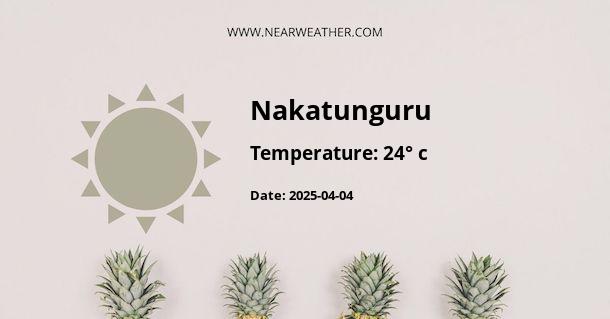Introduction
Nakatunguru is a fascinating location in Tanzania, East Africa, renowned for its remarkable weather patterns and unique climate. Its geographical position on the globe significantly influences its climate, contributing to the diverse experiences of weather throughout the year. This article will delve into the intricacies of Nakatunguru's climate, providing an in-depth analysis of its weather patterns throughout the year.
Geographical Location and General Climate
Nakatunguru is located in northeastern Tanzania, near the southern border of Kenya. It falls within the tropical savanna climate zone, characterized by significant temperature variations, moderate to high humidity, and two distinct seasons – the rainy and dry seasons.
The tropical savanna climate of Nakatunguru is marked by a wet season that typically occurs from March to May and a dry season that extends from June to October. This pattern is largely influenced by the movement of the Intertropical Convergence Zone (ITCZ), which brings rain-bearing winds to the region.
Temperature
The temperature in Nakatunguru varies moderately throughout the year. However, it generally remains warm, with an average annual temperature of about 22.2°C (72°F). The hottest months are typically January and February, just before the onset of the rainy season, with average highs reaching up to 25-28°C (77-82.4°F). Conversely, the cooler months are July and August, during the dry season, when average lows can drop to around 20°C (68°F).
Rainfall
Rainfall in Nakatunguru is highly seasonal, aligning with the typical characteristics of a tropical savanna climate. The area experiences a significant amount of rainfall during the wet season from March to May, with April being the wettest month. Precipitation levels can reach up to 200mm in this period. The dry season, running from June to October, witnesses very little rainfall, often less than 50mm per month.
Humidity and Wind
The humidity levels in Nakatunguru vary throughout the year, with the highest levels occurring during the rainy season. This is due to the increased evaporation rates resulting from higher temperatures and abundant rainfall. Wind patterns in Nakatunguru are predominantly influenced by the region's proximity to the Indian Ocean, with sea breezes commonly experienced.
Year-Round Weather Patterns
| Month | Average High Temperature | Average Low Temperature | Average Rainfall |
|---|---|---|---|
| January | 28°C (82.4°F) | 20°C (68°F) | 50mm |
Conclusion
In conclusion, Nakatunguru's climate can be described as a tropical savanna, characterized by moderate to high temperature variations, significant seasonal rainfall, and moderate to high humidity levels. This unique weather pattern contributes to the area's rich biodiversity and unique cultural practices. Understanding these patterns is crucial for planning travel, agricultural activities, and other human endeavors in the region. Therefore, a more comprehensive understanding of Nakatunguru's climate can contribute to better planning and decision-making, ultimately enhancing the region's sustainability and resilience in the face of climate change.
A - Nakatunguru's Latitude is -2.116670 & Longitude is 33.066669.
A - Weather in Nakatunguru is 24° today.
A - Climate Conditions in Nakatunguru shows light rain today.
A - Humidity in Nakatunguru is 73% today.
A - Wind speed in Nakatunguru is 12.24 km/h, flowing at 171° wind direction. today.
